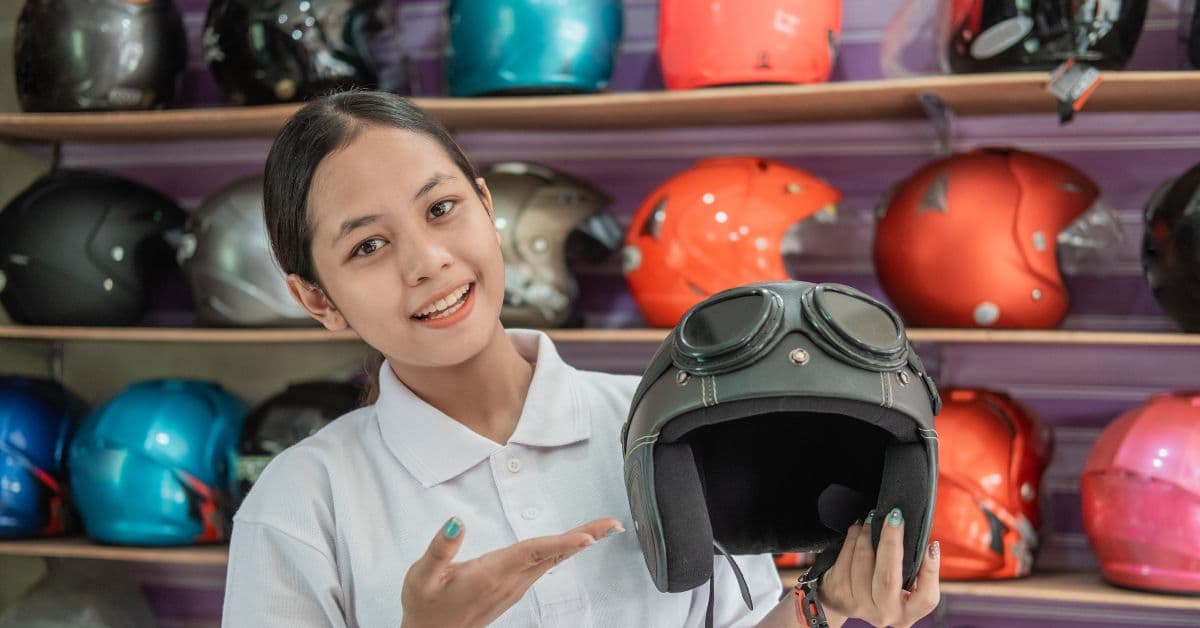scroll for more! ⟶
Cinchy Blog / Motorcycle Helmet Size Guide in Bali Indonesia
Motorcycle Helmet Size Guide in Bali Indonesia: How To Measure & Fit The Right Helmet
Published: 14 Jun 2025
By Ulfah Alifah
Travel Enthusiast

Book Your Ride in Just 1 Minute!
Free Cancellation
24/7 Support
Insurance
Start Date - End Date
Start Time
-- : -- --
End Time
-- : -- --
Duration
0 Day(s)
When planning to rent a scooter in Bali, choosing the right helmet size is not just about comfort – it's a legal requirement and a matter of life and death. Indonesian law mandates that both riders and passengers wear helmets that meet national safety standards, with fines of up to Rp 250,000 for violations. This comprehensive guide will help you understand how to measure and fit the perfect helmet for your Bali scooter rental adventure.
Why Helmet Fit Matters in Bali's Tropical Climate
Bali's hot, humid climate presents unique challenges for helmet selection. A properly fitted helmet must balance protection with ventilation to prevent overheating during long rides through the island's rice fields and coastal roads. Poor-fitting helmets can cause dangerous distractions, reduce protection effectiveness, and make your riding experience miserable in temperatures that regularly exceed 30°C.
The consequences of wearing an ill-fitting helmet extend beyond discomfort. In Bali's chaotic traffic conditions, where scooters navigate between cars, trucks, and other motorcycles, your helmet is your primary protection against head injuries. Insurance companies also require proper helmet use for coverage validation, making correct sizing essential for financial protection.
Understanding Indonesian Helmet Standards
Before measuring for size, it's crucial to understand that helmets in Indonesia must meet specific safety certifications. The mandatory SNI (Standar Nasional Indonesia) certification ensures helmets meet local safety requirements and is legally required for road use.
Popular helmet standards you'll encounter include:
SNI: Required for legal use in Indonesia
DOT: US Department of Transportation standard
ECE 22.05: European standard, considered more rigorous than DOT
Snell: Premium independent testing standard
When renting a scooter in Bali, always verify that your rental company provides SNI-certified helmets. Many rental shops offer helmets from reputable local brands like KYT, JPN, and INK, which typically range from 300,000 to 900,000 rupiah depending on type and features.
Read Also:
Where to Buy a Helmet in Bali? 10 Best Helmet Shops in Bali
How Often Should I Replace My Motorcycle Helmet?
The Complete Bali Helmet Guide: Safety, Legality, and Comfort in Indonesia's Tropical Paradise
What is the 2-2-2 Rule When Fitting a Helmet on Your Head?
How to Choose a Helmet for Riding a Scooter in Bali
Everything About Helmet Certification in Bali: SNI, DOT, ECE, SNELL
Types of Motorcycle Helmets in Bali Scooter Rental: A Safety Guide Through Paradise
Grab a Certified Helmet with Cinchy!
Tired of squinting at dodgy helmets that look like they’ve survived a war (or worse, a previous tourist)? Skip the sketchy markets and rental scams. At Cinchy, every scooter comes with two SNI-certified helmets – cleaned, sanitised, and ready to keep your noggin intact while you explore Bali’s chaos.
👉 Why stress?
✅ SNI-certified = Legal compliance + actual protection
✅ Free with every rental – No hidden costs, no haggling
✅ Hygiene first – Fresh hair nets and sanitised liners
✅ 24/7 support – Because Bali doesn’t sleep (and neither do we)
Click, Chat, Book – Easy as!
🚀 Snag Your Scooter & Helmet Combo Now 🚀
P.S. Prefer a brand-new helmet? Add one for just Rp70,000 (~AU$6.67) – because your head deserves VIP treatment. 😉
Cinchy: Where safety meets “mate, this is too easy” vibes.
For a hassle-free Bali experience, hiring a scooter in Bali from Cinchy is the best choice. Visit Cinchy and get ready to explore Bali with ease and enjoy your holiday to the fullest! Click here to book your scooter!
Step-by-Step Helmet Measuring Guide
How to know what size helmet to buy:
1. What You'll Need
Flexible measuring tape (seamstress or tailor's tape works best)
Mirror
Helper (recommended for accuracy)
Pen and paper to record measurements
2. Measuring Your Head Circumference
Find the Widest Point: Wrap the measuring tape around the fullest part of your head, approximately one inch above your eyebrows and just above your ears. This measurement point sits at your temples and extends around the natural bump at the back of your head.
Ensure Proper Tape Position: The tape should sit level around your head, not tilted up or down. Keep it snug but not tight – you should be able to slide the tape slightly but not lift it away from your head.
Take Multiple Measurements: Measure at least twice to ensure accuracy. If measurements vary, use the larger number to avoid getting a helmet that's too small.
Record in Both Units: Note your measurement in both centimeters and inches, as different manufacturers use different sizing systems.
3. Understanding Head Shapes
Head shape is equally important as size when selecting a helmet. Most manufacturers design helmets for three primary head shapes:
Long Oval: Head is longer front-to-back than side-to-side
Intermediate Oval: Slightly longer front-to-back (most common shape)
Round Oval: Nearly identical front-to-back and side-to-side measurements
If a helmet manufacturer doesn't specify head shape, it's typically designed for intermediate oval heads.
Helmet Size Conversion Chart
Size | Circumference (cm) | Circumference (inches) | US Hat Size |
XXS | 51-52 | 20.0-20.5 | 6⅜-6½ |
XS | 53-54 | 20.9-21.3 | 6⅝-6¾ |
S | 55-56 | 21.7-22.0 | 6⅞-7 |
M | 57-58 | 22.4-22.8 | 7⅛-7¼ |
L | 59-60 | 23.2-23.6 | 7⅜-7½ |
XL | 61-62 | 24.0-24.4 | 7⅝-7¾ |
XXL | 63-64 | 24.8-25.2 | 7⅞-8 |
Note: Always check the specific manufacturer's size chart, as sizing can vary between brands.
Testing Helmet Fit: The Complete Checklist
1. Initial Fit Assessment
When trying on a helmet, whether at a rental shop or purchasing your own for extended Bali stays, follow these steps:
Put It On Properly: The helmet should feel snug as it goes over your head. If it slides on too easily, it's likely too large.
Check Position: The helmet should sit level on your head with the front edge 1-2 finger widths above your eyebrows. The eye port should provide clear peripheral vision without obstruction.
Assess Pressure Points: There should be no "hot spots" where the helmet creates uncomfortable pressure. Even contact around your head is ideal, but avoid painful pressure points.
2. Movement Tests
Perform these tests while wearing the helmet:
Shake Test: Gently shake your head side to side and up and down. The helmet should move with your head, not slide around independently.
Roll Test: Try to roll the helmet forward and backward on your head. Excessive movement indicates poor fit.
Jaw Test: Open your mouth wide – the helmet should pull down slightly on your head due to proper chin strap tension.
3. Cheek Pad Assessment
Check that you can fit 1-2 fingers between the cheek pads and your cheeks. If there's too much space, consider a smaller size or helmets with adjustable cheek pads. Some manufacturers offer different cheek pad thicknesses for customization.
Helmet Types for Bali's Climate
1. Full-Face Helmets
Offer maximum protection and are ideal for highway riding and longer trips. Modern full-face helmets feature advanced ventilation systems with intake and exhaust vents to manage Bali's heat. Look for helmets with NACA duct ventilation technology for optimal airflow.
2. Open-Face Helmets
Provide excellent airflow, making them popular for short city rides in hot weather. However, they leave your face exposed to sun, rain, and road debris. Ensure any open-face helmet includes a visor or use quality sunglasses.
3. Modular Helmets
Combine full-face protection with open-face convenience. The flip-up chin bar allows for better airflow when stopped while maintaining protection during riding.
4. Half Helmets
Offer maximum airflow but minimal protection. While legal in Indonesia with SNI certification, they provide limited coverage and aren't recommended for inexperienced riders or high-speed riding.
Special Considerations for Bali
1. Ventilation Features
Bali's tropical climate makes ventilation crucial. Look for helmets with:
Multiple intake vents at the front
Exhaust vents at the rear
Internal air channels
Moisture-wicking liner materials
Research shows that proper ventilation can significantly reduce heat buildup and sweating. However, avoid helmets with excessive ventilation that compromises structural integrity.
2. Hygiene and Maintenance
Rental helmets in Bali may have hygiene concerns. Choose rental companies that provide sanitized helmets or consider purchasing your own for extended stays. Look for helmets with removable, washable liners for easy cleaning.
3. Local Brands and Availability
Popular helmet brands available in Bali include KYT, JPN, INK, and international brands like AGV, Arai, and Nolan. Local brands offer good value and meet SNI requirements, typically costing 300,000-400,000 rupiah for half-face helmets and 400,000-900,000 rupiah for full-face models.
Common Fitting Mistakes to Avoid
1. Size-Related Errors
Choosing based on hat size alone: Helmet sizing differs from hat sizing
Ignoring head shape: A helmet can be the right size but wrong shape
Going too large: Helmets loosen over time, so start with a snug fit
2. Position Mistakes
Wearing too high: Leaves forehead exposed and reduces protection
Wearing too low: Obstructs vision and is uncomfortable
Improper strap adjustment: Loose straps render helmets ineffective
3. Climate Considerations
Ignoring ventilation needs: Critical in Bali's hot, humid climate
Choosing style over function: Prioritize safety and comfort over appearance
Forgetting sun protection: Ensure adequate visor coverage for tropical sun
Legal Requirements and Enforcement
Indonesian traffic law requires both drivers and passengers to wear SNI-certified helmets. Police conduct regular helmet checks, especially during the annual "Operasi Patuh Agung" campaigns. Violations result in fines up to Rp 250,000 and possible imprisonment of up to one month.
Even traditional Balinese riders wearing ceremonial udeng headdresses must wear helmets when riding motorcycles. The law applies to all motorcycle operators regardless of cultural or religious dress.
Rental vs. Purchase Decision
1. When to Rent
Short trips (less than one week)
Occasional use
Budget constraints
No storage concerns
2. When to Buy
Extended stays (more than two weeks)
Daily use
Hygiene preferences
Long-term cost savings
Quality helmet shops in Bali include Bali Helmet Gallery in Denpasar and various retailers throughout tourist areas. Online platforms like Tokopedia offer extensive selections with home delivery.
Conclusion
Selecting the right helmet size for your Bali scooter rental experience requires careful measurement, understanding of Indonesian safety standards, and consideration of tropical climate factors. A properly fitted SNI-certified helmet not only keeps you legal but provides essential protection in Bali's challenging traffic conditions.
Remember that helmet fit affects both safety and comfort during your Indonesian adventure. Take time to measure correctly, test fit thoroughly, and choose appropriate ventilation features for the climate. Whether renting or purchasing, prioritize safety certifications and proper fit over appearance or price.
Your helmet is your most important piece of safety equipment when exploring Bali by scooter. Invest the time to get it right, and you'll enjoy safer, more comfortable rides through one of the world's most beautiful islands.

